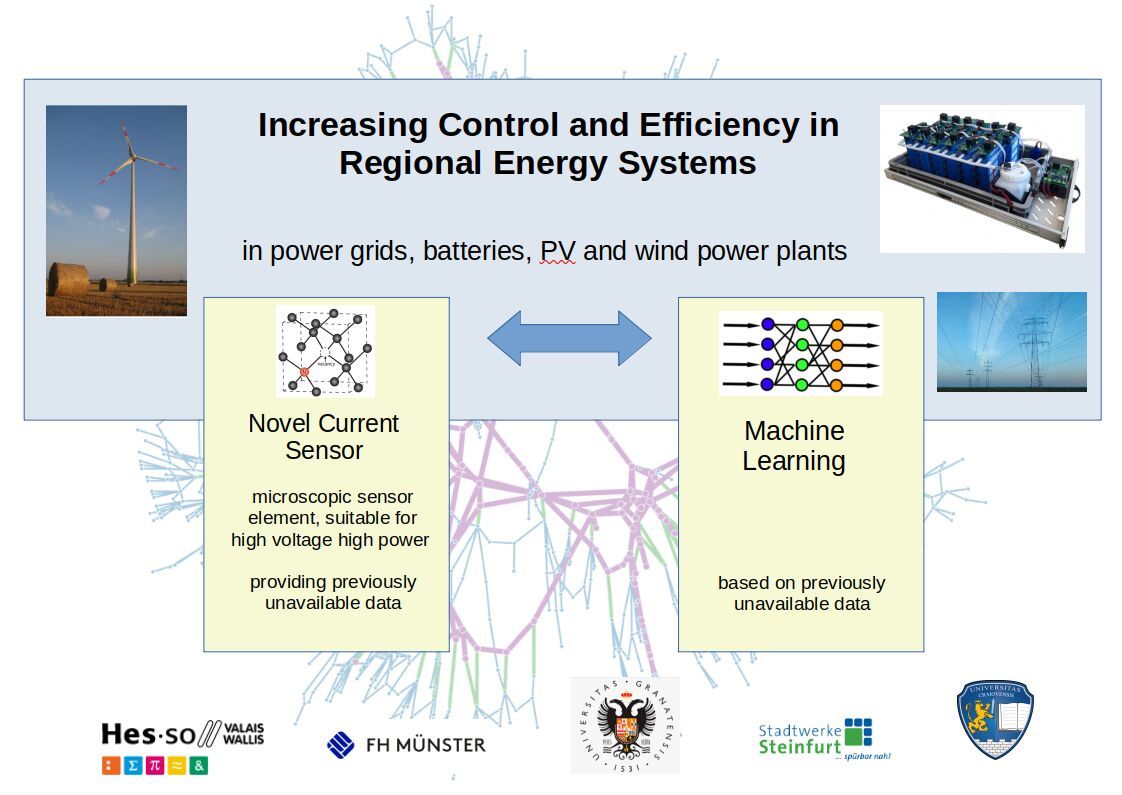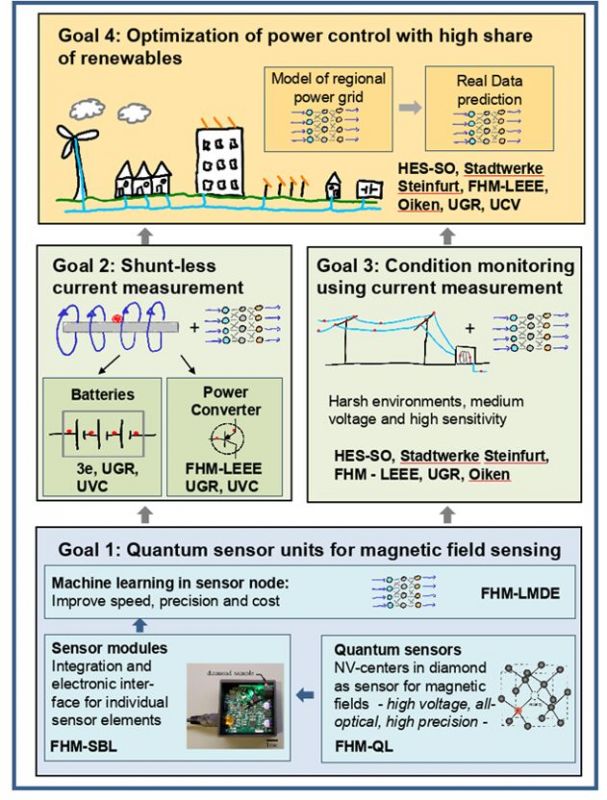QuantumIRES
Increasing control and efficiency in regional energy systems using quantum sensors and machine learning (QuantumIRES)
The outstanding crisis of our time, climate change, and also the ongoing war in Ukraine, are forcing us as a society to pursue greater energy efficiency and shift away from fossil fuels towards renewable sources. However, the complexity of the operation and control of power grids is drastically increased by the integration of renewable energy with decentralized feed-in from regenerative energies and dynamic demand responses. Traditionally, power supply by power plants varies on a long time scale in the range of hours. Now, fluctuations take place in the order of minutes. To prevent power systems from becoming increasingly vulnerable to blackouts, the flexibility of power grids urgently needs to be enhanced by improved status control and optimization. For this purpose, a current measurement that is as precise as possible within electrical conductors and power semiconductors is crucial in order to enable efficient control at all levels.
The intended cooperation project is thus dedicated to the research topic of ML (Machine Learning) supported quantum sensors based on NV centres with the aim of enabling an integrated regional smart energy system of high flexibility. This corresponds to the first dimension of integration of the call - Smart energy system integration.
The success of the future interlocking of regenerative energy sources is guaranteed by the communication between sub-components of generation and storage, consumers, machines and people, i.e. relating to the third dimension of integration of the call - Innovation ecosystems and Integration with local & regional development. It primarily depends on the availability of stable, permanent and, above all, decentralized status recording. The basic prerequisite for this, however, is that the current major shortcomings in the existing technologies can be overcome in order to make their acceptance possible in the first place.
The primary goal of the proposed project is to put forward a lossless and purely optically connected current measurement in combination with ML techniques for the monitoring of medium voltage power lines and power converters for grid connected batteries and renewables (Fig. 1). Within the planned collaboration, proven research findings from the fields of quantum technologies will be used or further developed in order to connect the sensors and the respective associated quantum elements in a self-calibrating manner without hysteresis and memory effect. At the high level of the system, ML will be used remotely or locally to classify its state from data signals collected at a (small) number of points, allowing for the early identification of disturbances and for proposing efficient countermeasures. At the individual level, ML approaches will be employed to analyse the fluorescence spectra and predict the magnetic field, as well as, the current within the quantum sensors. Also, the charge and health states of the batteries will be derived through prediction from numeral data and image spectra. In a next step, the optimization of battery usage, and ultimately of the power grid, will be carried out by examining the prediction of ML techniques for time series analysis regarding the consumption and photovoltaic production. The time series will, in addition to the data from the quantum sensors, also encompass exogenous variables, such as weather, cloud drift and solar irradiance; the last two will be predicted from sky camera images. In this way, the power distribution of the network, e.g. the scheduling of charging processes and consumption, can be optimized on the base of the ML forecasting. This will affect all involved economic sectors, e.g. municipal infrastructure, industry, agriculture, transport, as connected with the second dimension of integration of the call - Cross-sectoral integration.
Goal 1: Quantum sensor units for magnetic field sensing
The NV-center based quantum sensor will be used to measure magnetic fields in applications previously unavailable or too expensive by conventional sensor concepts. The sensors are based on microdiamonds with a high concentration of NV-centers. These microdiamonds will be coupled to optical fibers to form an optical magnetic probe or can directly be integrated into electronic circuits. These sensor units will comprise of the optical and microwave interface and control electronics. Until the end of this project the sensor units will show comparable performance as conventional Hall-sensors in terms of accuracy and temperature. Additionally, even at this point, the units will be incorporating ML to deduce the magnetic field effectively from the measured sensor data.
Goal 2: Shuntless current measurement in the field of battery management and power converters for renewables
The control unit of a battery management system is dependent on the acquisition of the individual module currents, e.g. for load balancing. The series connection of the individual modules results in high voltage differences between the modules, so that potential-free current measurement is desirable. By using a current sensor based on NV centers, no energy losses in the current path and purely optical measurement connection is made possible and, with ML capabilities, parameters such as State of Charge (SoC) and State of Health (SoH) can be instantaneously derived at arbitrary environmental conditions.
Goal 3: Condition monitoring using current measurement in medium-voltage lines
Dynamic power control in the medium-voltage grid will gradually become important with increasing decentralized feed-in from regenerative energies. Here, the promising new approach for the power lines is the use of NV centers in an all-optical galvanically isolated current sensor. By using fiber optics, a potential-free connection and loss-free measurement at different points of the infrastructure is possible, greatly increasing the number of sensors in the grid. ML is used to supervise the state of the system, e.g. by detecting outliers representing faulty or unstable states of the power line system. Crucially, for this classification, it is not necessary to completely characterize the system by performing vast measurements.
The quantum current sensors will be tested in laboratory environment. ML will be developed for state estimation of an MV power grid using data from real current measurements from the industry partners SWS and Oiken and data derived from MV power grid simulations using physical power grid models like DiIgSILENT PowerFactory or DIstribution Network GeneratOr - DING0. The condition monitoring accuracy of our system will then be verified using comparison with the physical models. We expect less than 10% deviation for the full range of the specified environmental conditions.
Goal 4: Optimization of power system control with high shares of renewables and energy storage devices
One important goal of the project is to gain a better real time understanding of the local power grid in order to be able to better control it regarding high shares of renewables and storage devices. This is also required for advanced power system technologies like demand side response or vehicle-to-grid, which can provide a great benefit in power system management, but need input about the grid state to work properly. In order to achieve this goal, we will use a combined approach of new sensor technology, ML algorithms and nature-inspired optimization techniques. We expect a substantial improvement of the understanding of the local power grid state in terms of power flow and the available flexibility, as not being very well observed at the moment. Optimization is possible towards increased reliability and safety, less loss of energy from renewables and a reduction of money spent on countermeasures towards grid overload conditions (in Germany 3% of the renewable electric energy could not be used due to grid limitations in 2021).
One particular optimization goal is a better charging algorithm for smaller batteries used for PV-self-consumption-optimization. These batteries usually take over the household electric load during the night or other periods with less PV production than consumption. The batteries are then recharged when there is excess PV power available until the battery is fully charged. Then excess power is more or less abruptly fed back into the grid, causing a steep gradient in power delivery to the grid. This can cause problems with the control of the voltage and power distribution in low- and medium voltage power grids. A better charging strategy would be to slowly charge the battery in a way that it is fully charged just in the moment the PV production falls below consumption. This would also reduce losses in the battery system, as most parts of the battery losses correlate to the charge and discharge power. Of course, it is hardly possible to achieve this perfect charging strategy exactly, but improved local forecast of PV production developed in this project will help to get much closer to the optimal solution than possible today. Furthermore, such batteries can also be use to stabilize the grid by charging it when there is too much production a relevant part of the grid and is charged with lower power or even discharged, when there is too high consumption. This requires a better knowledge of the state of the power grid, which is usually quite poor today especially in the low and medium voltage grids. Low-cost quantum current sensors combined with ML as proposed in this project could greatly improve the condition monitoring of these parts of the power grid. Beneficial effects to the power grid from our findings will be verified in the physical models. IEA expects a worldwide flexibility potential of 185 GW resulting in cost reductions of 270 billion USD from such measures.
Projektleitung
Prof. Dr.-Ing. Peter Glösekötter
Fachbereich Elektrotechnik und Informatik
Stegerwaldstraße 39
48565 Steinfurt
Tel: 02551 9-62223
Fax: 02551 9-62473
peter.gloesekoetterfh-muensterde
Prof. Dr. Markus Gregor, Prof. Dr. Tilman Sanders, Prof. Dr. Sarah Trinschek
Mitarbeitende
- Ann-Sophie Rösner M.Sc.
Projektzeitraum
Kooperationspartner
- University of Granada
Periodista Daniel Saucedo Aranda s/n
18071 Granada, Spain - Haute école spécialisée de Suisse occidentale - HES-SO
Route de Moutier 14
2800 Sion, Switzerland - Stadtwerke Steinfurt
Wiemelfeldstr. 48
48565 Steinfurt - UNIVERSITATEA DIN CRAIOVA - UCV
A I CUZA STREET 13
200585 Craiova, Romania - energy environment economics 3e GmbH
Tußmannstr. 61
40477 Düsseldorf - Oiken SA
Industrie 43
1950 Sion, Switzerland
Finanzierung
- EU, BMWK, Förderkennzeichen 03EI6113A




